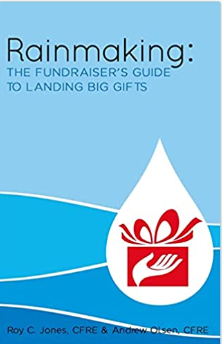Beware of the major gift guru who says he has the secret black book with the list of his major donor friends who will fund your charity. Outside lists of major donors to other charities (assuming your “guru” is telling the truth) are not the best place for you to prospect for major donors. Just because a wealthy donor writes a big check to another charity does not mean that they will write a big check to you.
Major gift “specialists” who peddle their “black book” are a dime a dozen. I call them butterflies and bumble-bees because they move from flower to flower (organization to organization) and sting a bunch of people along the way. They usually string the charity out over a couple of years by saying it takes 18 to 24 months to get a major gift. The charity in good faith pays them for a 18 months or more, but as they approach the end of the timeline the major gift guru takes their last paycheck, gathers up the “back book” and heads down the road to the next charity. Be careful…. Or should I say, “bee careful, don’t get stung!”
Major donors must possess two key characteristics to make them a top prospect to your organization: (1) they must be wealthy and have the financial capacity to make a large gift (but capacity alone is not enough); (2) the donor must have demonstrated an intent or affinity to support your organization. What is the best indicator of donative intent? Previous giving history! Have they written a check to you before? And if so, how many checks have they written and for how much. Donative intent is as important as wealth in identifying your best major gift prospects.
The best place to start in identifying prospects is YOUR regular donor file. You need to create several key reports in order to rank you donors each year from the most likely to the least likely to make a major gift. The fact is that these reports mirror the same strategies you may already be using with your regular direct response fundraising in the mail and on line. RFM is critical to major gift fundraising. It stands for recency, frequency and monetary amount.
You need to create an overlay using a battery of reports in order to place your prospect in order of priority. Ranking your prospects and regularly updating the list is critical to success. It truly become the radar screen that enables you to always focus on your best prospects first.
Personally, I like to create a simple excel spreadsheet with a row for each donor with their complete contact information and a column for each category of their giving. (Yes, this is an “old school” technique and I am probably dating my self with this approach) However, most CRM databased have a function to update and rank your database automatically. In addition, the modern “dashboard” I’ve seen created included will make your head spin with automated tracking and contact management functionality. The bottom line though that the best systems track donor activity by RFM.
Here is my simple process for identifying your top prospects for a major gift:
MONETARY. Your reporting needs to first help you analyze the dollar amounts of each donor on your file in order to rank your major gift prospects. The dollar amounts you should be looking for are HPC (highest previous contribution); MRC (most recent contribution); TAC (total annual contributions, I like have a separate column for each calendar year and normally include a minimum of the last 3 calendar years); and TLC (total lifetime contribution amount / total giving; of course, this is the actual life time value of each donor without averaging).
FREQUENCY. Secondly, your major donor prospect grid should look at frequency. This is the number of gifts (regardless of amount). Remember, no other factor is a better indicator of donative intent and affinity to your charity than the number of donations they have made to your organization. I recommending creating a column for the NLG (number of lifetime gifts); NAG (number of annual gifts). Once again, I would create a separate column for each calendar year and normally include a minimum of the last 3 calendar years.
The donors that write the most number of checks each year are usually better major gift prospect than your one-time a year givers. I am not saying to ignore your single gift annual donors. I am just stating the fact that your “multi-donors” are going to me more approachable. “Multi-donors” are more willing to talk to you on the phone and much quicker to take a meeting with you.
RECENCY. Lastly, and most importantly, you need to look at the MRC dates and track them closely (most recent contribution). Your best prospect for a major gift is always your recent donor. Tracking the dates of donations is critical and using those dates as a trigger to contact the donor is even more critical. The old adage that best describes the importance of recency may be “what have you done for me lately?” In my spreadsheet for ranking major donor prospect I usually create a minimum of four columns listing four most recent dates they made a contribution.
Acknowledging recent donations through a personalized letter, regardless of giving channel (on line, events or in the mail), is critical to getting the next gift. Remember, major donors do not make donations. They make investments. The bigger the gift the more attention you need to shower on the donor. It is critical to building relationships that produce bigger and bigger major gifts.


